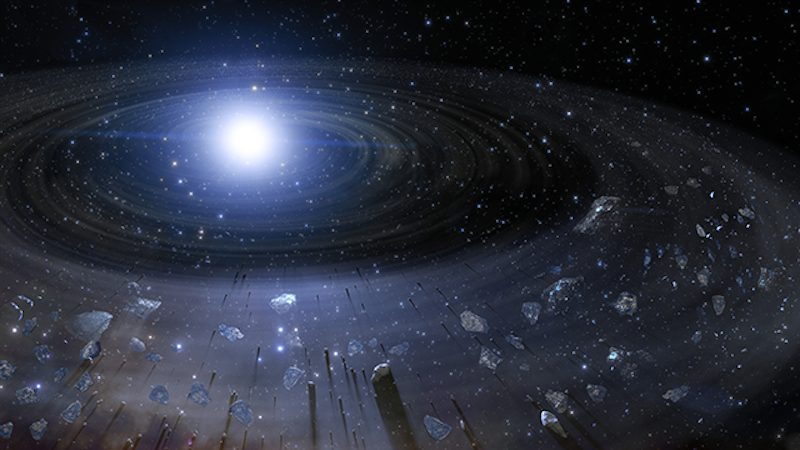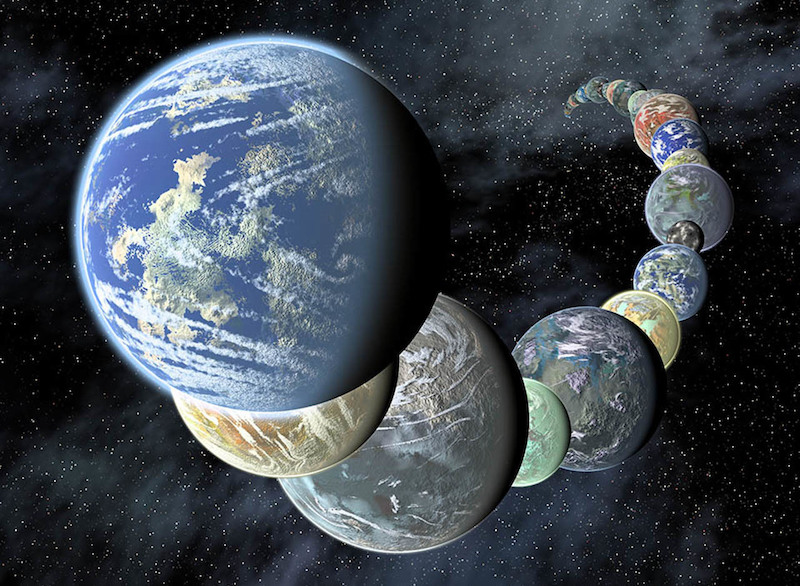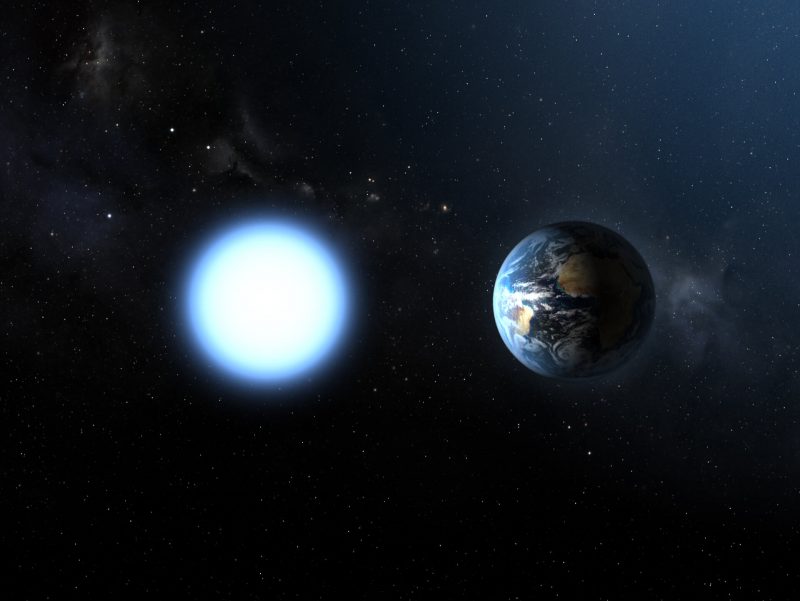
Exoplanets – worlds orbiting other stars – appear to be scattered throughout our Milky Way galaxy. Astronomers estimate they number in the billions. A good percentage of those worlds are rocky, like Earth or Mars in our solar system, for example. But are they similar? Researchers from NOIRLab and California State University, Fresno, announced on November 2, 2021, that there are many weird rocky exoplanets, unlike any found in our solar system.
The researchers analyzed the elemental remains of such worlds that “polluted” the atmospheres of their host stars – evolved stars known as white dwarfs – after the planets disintegrated. The peer-reviewed journal Nature Communications published the intriguing results on November 2.
White dwarf stars provide clues
The researchers, led by Keith Putirka and Siyi Xu, made the findings by studying 23 white dwarf stars within 650 light-years of Earth. White dwarfs are the remaining burnt-out cores of stars that were once much like our own sun. Any planets may be long gone, but the leftover debris can pollute the atmospheres of the white dwarfs.
Scientists can learn about former planets that once orbited the stars by analyzing the atmospheres of the white dwarfs. They look for any foreign elements that wouldn’t normally be present as a natural part of the white dwarf itself (hydrogen and helium). Such elements could include calcium, silicon, magnesium and iron. By measuring the abundances of different elements, scientists can figure out the composition of the minerals and rocks they originally came from.

Scientists made the detailed observations with the W. M. Keck Observatory’s High-Resolution Echelle Spectrometer (HIRES) on Maunakea in Hawaii, the Hubble Space Telescope (HST) and other observatories. As Xu stated:
Combining the high sensitivity of Keck’s HIRES instrument and Hubble’s Cosmic Origins Spectrograph is the best way to measure the chemical compositions of extrasolar planetary materials accreted onto polluted white dwarfs.
Weird rocky planets with a wide range of compositions
Surprisingly, the researchers found that the polluting debris in the white dwarfs had a wider range of compositions than expected. This means that the original planets the debris came from were composed of a wide variety of rock types. Their composition was more varied than the rocky planets in our own solar system. Some of the planets were likely similar to Earth in composition, but others were a lot more unusual. Elements discovered so far include calcium, silicon, magnesium and iron.
As noted in the paper:
Polluted white dwarfs reveal greater planetary variety in our solar neighborhood than currently appreciated, with consequently unique planetary accretion and differentiation paths that have no direct counterparts in our solar system.
Incredibly, some of the minerals were so unusual, the researchers had to come up with new names for them. “Quartz pyroxenites” and “periclase dunites” are two examples. As Xu noted:
While some exoplanets that once orbited polluted white dwarfs appear similar to Earth, most have rock types that are exotic to our solar system. They have no direct counterparts in the solar system.

The debris from the planets that once orbited the stars provides valuable clues as to what those worlds were like. As Putirka added:
Some of the rock types that we see from the white dwarf data would dissolve more water than rocks on Earth and might impact how oceans are developed. Some rock types might melt at much lower temperatures and produce thicker crust than Earth rocks, and some rock types might be weaker, which might facilitate the development of plate tectonics.
Previous studies
This is not the first time scientists have found evidence for planets in the atmospheres of white dwarfs. Researchers have discovered elements such as calcium, aluminum, lithium, potassium and sodium before. As noted by the researchers, those are minor elements. Those kinds of elements only make up a small percentage of the composition of rocks on Earth. However, to understand what a former planet was actually composed of, scientists need to examine major elements such as silicon. Those elements are the most abundant in Earth rocks.
Previous studies of elements in white dwarfs showed evidence for continental crusts existing on the planets. In the case of these new white dwarfs, however, researchers think the elements originated from deeper inside the planets, from their mantles. They have not found evidence for continental crusts yet.

According to Putirka:
We believe that if crustal rock exists, we are unable to see it, probably because it occurs in too small a fraction compared to the mass of other planetary components, like the core and mantle, to be measured.
The uniqueness of Earth
The new results are exciting and will help scientists understand how rocky planets form and evolve. They will also help answer questions about why Earth evolved the way it did and what makes it unique. As stated in the paper:
Exoplanet studies also force us to face still unresolved questions of why Earth is so utterly different from its immediate planetary neighbors, and whether such contrasts are typical or inevitable.
Bottom line: Astronomers say they have new evidence for weird rocky exoplanets unlike any in our own solar system. They base their findings on the chemical analysis of white dwarf stars. Leftover debris from the now long-gone planets “pollutes” the atmospheres of the stars.
The post Weird rocky exoplanets unlike any seen before first appeared on EarthSky.
from EarthSky https://ift.tt/3bXabAK

Exoplanets – worlds orbiting other stars – appear to be scattered throughout our Milky Way galaxy. Astronomers estimate they number in the billions. A good percentage of those worlds are rocky, like Earth or Mars in our solar system, for example. But are they similar? Researchers from NOIRLab and California State University, Fresno, announced on November 2, 2021, that there are many weird rocky exoplanets, unlike any found in our solar system.
The researchers analyzed the elemental remains of such worlds that “polluted” the atmospheres of their host stars – evolved stars known as white dwarfs – after the planets disintegrated. The peer-reviewed journal Nature Communications published the intriguing results on November 2.
White dwarf stars provide clues
The researchers, led by Keith Putirka and Siyi Xu, made the findings by studying 23 white dwarf stars within 650 light-years of Earth. White dwarfs are the remaining burnt-out cores of stars that were once much like our own sun. Any planets may be long gone, but the leftover debris can pollute the atmospheres of the white dwarfs.
Scientists can learn about former planets that once orbited the stars by analyzing the atmospheres of the white dwarfs. They look for any foreign elements that wouldn’t normally be present as a natural part of the white dwarf itself (hydrogen and helium). Such elements could include calcium, silicon, magnesium and iron. By measuring the abundances of different elements, scientists can figure out the composition of the minerals and rocks they originally came from.

Scientists made the detailed observations with the W. M. Keck Observatory’s High-Resolution Echelle Spectrometer (HIRES) on Maunakea in Hawaii, the Hubble Space Telescope (HST) and other observatories. As Xu stated:
Combining the high sensitivity of Keck’s HIRES instrument and Hubble’s Cosmic Origins Spectrograph is the best way to measure the chemical compositions of extrasolar planetary materials accreted onto polluted white dwarfs.
Weird rocky planets with a wide range of compositions
Surprisingly, the researchers found that the polluting debris in the white dwarfs had a wider range of compositions than expected. This means that the original planets the debris came from were composed of a wide variety of rock types. Their composition was more varied than the rocky planets in our own solar system. Some of the planets were likely similar to Earth in composition, but others were a lot more unusual. Elements discovered so far include calcium, silicon, magnesium and iron.
As noted in the paper:
Polluted white dwarfs reveal greater planetary variety in our solar neighborhood than currently appreciated, with consequently unique planetary accretion and differentiation paths that have no direct counterparts in our solar system.
Incredibly, some of the minerals were so unusual, the researchers had to come up with new names for them. “Quartz pyroxenites” and “periclase dunites” are two examples. As Xu noted:
While some exoplanets that once orbited polluted white dwarfs appear similar to Earth, most have rock types that are exotic to our solar system. They have no direct counterparts in the solar system.

The debris from the planets that once orbited the stars provides valuable clues as to what those worlds were like. As Putirka added:
Some of the rock types that we see from the white dwarf data would dissolve more water than rocks on Earth and might impact how oceans are developed. Some rock types might melt at much lower temperatures and produce thicker crust than Earth rocks, and some rock types might be weaker, which might facilitate the development of plate tectonics.
Previous studies
This is not the first time scientists have found evidence for planets in the atmospheres of white dwarfs. Researchers have discovered elements such as calcium, aluminum, lithium, potassium and sodium before. As noted by the researchers, those are minor elements. Those kinds of elements only make up a small percentage of the composition of rocks on Earth. However, to understand what a former planet was actually composed of, scientists need to examine major elements such as silicon. Those elements are the most abundant in Earth rocks.
Previous studies of elements in white dwarfs showed evidence for continental crusts existing on the planets. In the case of these new white dwarfs, however, researchers think the elements originated from deeper inside the planets, from their mantles. They have not found evidence for continental crusts yet.

According to Putirka:
We believe that if crustal rock exists, we are unable to see it, probably because it occurs in too small a fraction compared to the mass of other planetary components, like the core and mantle, to be measured.
The uniqueness of Earth
The new results are exciting and will help scientists understand how rocky planets form and evolve. They will also help answer questions about why Earth evolved the way it did and what makes it unique. As stated in the paper:
Exoplanet studies also force us to face still unresolved questions of why Earth is so utterly different from its immediate planetary neighbors, and whether such contrasts are typical or inevitable.
Bottom line: Astronomers say they have new evidence for weird rocky exoplanets unlike any in our own solar system. They base their findings on the chemical analysis of white dwarf stars. Leftover debris from the now long-gone planets “pollutes” the atmospheres of the stars.
The post Weird rocky exoplanets unlike any seen before first appeared on EarthSky.
from EarthSky https://ift.tt/3bXabAK

Aucun commentaire:
Enregistrer un commentaire